
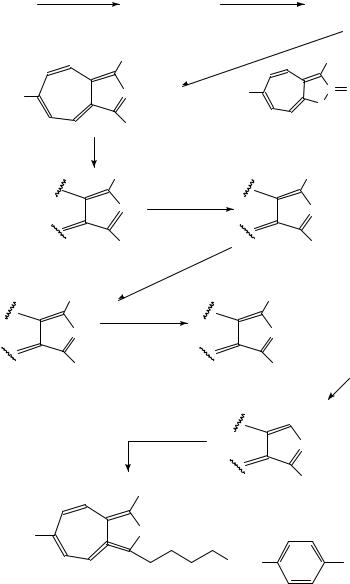
18. Syntheses and uses of isotopically labelled dienes and polyenes |
835 |
||||
BnO(CH2 )5Br |
BnO(CH2 )5 CN |
1. DIBA H, toluene |
BnO(CH2 )5 CHO |
|
|
K CN |
|
2. 2% aq. H2 SO4 |
|
||
18-crown-6, MeCN |
|
|
|
||
|
|
morpholine, EtOH |
|
|
|
|
COOMe |
|
COOMe |
|
|
Me2 HC |
*C |
|
Me2 HC |
C O |
|
|
O |
|
|||
|
|
|
|
|
|
|
(CH2 )4 OBn |
|
|
|
|
C6 H5OMe |
A ICl3 |
|
|
|
|
|
COOMe |
|
COOMe |
|
|
|
*C |
phthalimide, DEA D |
*C |
|
|
|
|
|
|
||
|
|
Ph3 P, THF |
|
|
|
|
(CH2 )4 OH |
|
(CH2 )4 NPht |
|
|
|
|
EtOH |
|
|
|
|
|
hydrazine hydrate |
|
(66) |
|
COOMe |
|
COOMe |
|
||
|
ClC6 H4SO2 Cl |
|
|
|
|
*C |
aq. NaHCO3 , acetone |
*C |
|
|
|
(CH2 )4 NH2 |
|
(CH2 )4 NHSO2 C6 H4 Cl-p |
|
||
|
|
|
|
100% H3 PO4 |
|
1. SO3 /Py/benzene
*C
2. MeONa/MeOH
(CH2 )4 NHSO2 C6 H4 Cl-p
SO3 Na
DEAD = EtOOCN NCOOEt NPht = phthalimido
NCOOEt NPht = phthalimido
Me2 CH |
*C |
|
NHSO2 |
Cl |
(184) 1.9 GBq, specific activity 2.36 GBq mmol−1, 85% step yield, 99% HPLC purity
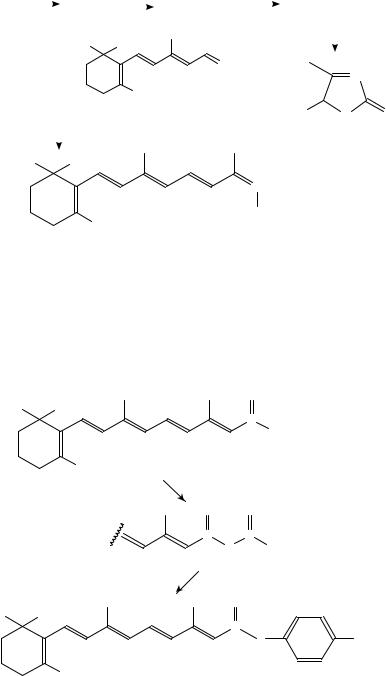
836 |
|
Mieczyslaw Zielinski´ |
and Marianna Kanska´ |
|
|
|
||||||||
Ba CO |
|
CO |
6 steps |
|
|
|
|
|
(EtO) |
P CH COOMe |
||||
|
|
Br |
CH2 COOMe |
|
|
|||||||||
|
|
|||||||||||||
3 |
2 |
|
|
2 |
2 |
|
||||||||
|
|
|
|
Me |
|
|
|
|
|
|
|
MeCOCH(OMe)2 |
||
|
|
Me |
Me |
|
|
|
|
|
|
|
|
|
|
|
|
1. |
|
|
|
|
PPh3 |
|
|
|
|
|
C |
|
|
|
Me |
|
|
|
|
|
|
|
|
|
||||
|
|
|
|
|
|
|
|
|
|
|||||
|
|
|
|
|
|
|
|
|
|
|
|
|
||
|
|
|
(187) |
|
|
|
|
|
HO |
|
O |
O (67) |
||
|
|
|
2. isomerization |
|
|
|
|
|
|
|
(186) |
|
||
|
|
|
Me |
|
|
Me |
|
|
|
|
|
|
|
|
|
|
|
|
|
|
|
|
|
|
|
|
|||
Me Me
*
C
COOH
Me
(185)
8. Synthesis of 4-(N-acetylamino)phenyl-1-[14C] retinoate
The title compound 188, currently under development for the treatment of acne, psoriasis and photoaging via a topical application, has been synthesized161 in two steps by reacting carboxyl-[14C]vitamin A, 189, with ethyl chloroformate and subsequent treatment of the mixed anhydride 190 with acetamidophenol in the presence of a catalytic amount of 4-dimethylaminopyridine (equation 68), Carbon-14-labelled compound was needed to investigate its metabolism and the extent of systematic adsorption of 188 after dermal application.
Me |
Me |
O |
Me Me
*C
OH
Me (189)
Me |
O |
O |
|
|
*C |
*C |
(68) |
|
O |
OH |
|
|
|
||
|
(190) |
|
|
|
Me |
Me |
O |
Me |
Me |
|
*C |
|
|
|
O |
NHCOMe |
Me
(188) 42% overall yield, 97.5% radiochemical purity, specific activity 23 Ci mg−1
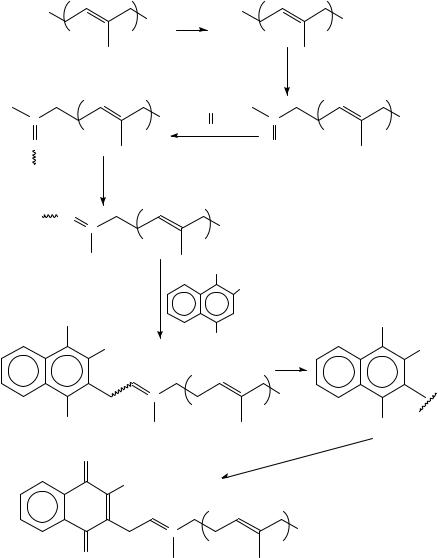
18. Syntheses and uses of isotopically labelled dienes and polyenes |
837 |
9. Synthesis of all-trans-[3-14C]menaqinone-4
All-trans-menaquinone-4, 191, potentially useful for therapy of hypoprothrombinemia due to vitamin K deficiency, has been synthesized162 using ethyl [3-14C]acetoacetate as shown in equation 69, for drug disposition studies in animals.
HO |
|
Br |
|
|
H |
PBr3 |
H |
|
3 |
|
3 |
|
|
2. NaOH, 2 h reflux 1. Me COCH2 COOEt, MeONa, dioxane |
|
* |
|
O |
|
H |
* |
H |
|
C |
C |
||
|
3 |
(EtO)2 PCH2 COOEt |
3 |
CH |
|
O |
|
COOEt |
|
|
|
|
LiA lH4 |
|
|
HOCH2 |
HC * |
H |
|
|
C |
|
|
|
|
3 |
|
|
|
OA c |
|
|
|
Me |
|
|
|
, EtO2 • BF3 |
(69) |
|
OAc |
|
OH |
|
Me |
OH |
Me |
|
|
||
|
* |
H |
|
|
C |
|
|
|
|
3 |
|
|
OH |
|
OH |
|
O |
|
A g2 O |
|
|
|
|
|
Me |
|
|
|
* |
H |
|
|
C |
|
|
|
|
3 |
|
O
C = 14 C
(191)overall radiochemical yield 12%, specific activity 669 MBq mmol−1, trans isomer ≥ 96% after chromatography and recrystallization
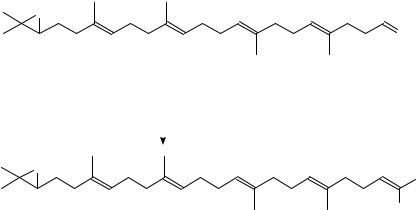
838 |
Mieczyslaw |
Zielinski´ and Marianna Kanska´ |
10. Synthesis of [24,30-14C]-labelled-2,3-epoxysqualene
[24,30-14C]-(3S)-2,3-epoxysqualene and its racemate have been prepared by two routes in a metabolically non-labile position relative to the demethylation of lanosterol to cholesterol (equation 70 and 71). The racemic [24,30-14C]-2,3-epoxysqualene, 192, has been obtained163 by condensation of (3S, 3R)-2,3-epoxytrisnorsqualene aldehyde 193 with freshly prepared 14C-labelled isopropylidenephosphorane, 194 (equation 70).
O
|
|
|
|
|
O |
|
(193) |
||||
THF, −78 °C (2 h) |
|
(CH3 )2 |
C |
|
PPh3 |
|
|
||||
|
|
||||
then −5 °C (2 h) |
|
|
|||
|
|
(194) |
(70) |
||
|
|
|
|||
|
|
|
|
|
|
O
CH3
CH3
C = 14 C
(192)60% yield, 301 Ci, specific activity 51 mCi mmol−1
The optically active (3S)-14C-labelled 2,3-epoxysqualene 195 has been prepared163 by treating (3S)-2,3-epoxytrisnorsqualene aldehyde 196 with (14CH3)2CDPPh3 in THF solution as shown in equation 70. The (20S)-(4E,8E,12E,16E)-20,21-epoxy-4,8,13,17,21- pentamethyl-4,8,12,16-decosatetraen-1-al, 196, has been synthesized in six steps as shown in equation 71.
Optically active (3S)-form, 195, is a key intermediate in the biochemical synthesis of triterpenes and sterols in vertebrates, plants and fungi164.
11. Synthesis of 14C-chloroacetates of 2-demethylthiocolchicine, 197, of 3-demethyl- thiocolchicine, 198, of N -acetylcolchinol, 199, and of the 14C-9-isocyanato-9-deoxy- N-acetylcolchinol, 200
The title compounds 197 and 198, covalently binding with high specificity to the ˇ- subunit of tubulin165,166,169, have been obtained167 by treating 2-demethylthiocolchinine, 201, and 3-demethylthiocolchinine, 202, respectively with ClCH214COCl in CH2Cl2 solution containing triethylamine.
The radiolabelled 9-chloroacetoxy-N-acetylcolchinol, 199, has been prepared167 by reacting N-acetylcolchinol 203 dissolved in CH2Cl2 and containing Et3N, with ClCH214COCl during 24 h at 55 °C.
The radiolabelled isothiocyanate 200 has been prepared167 by an early published procedure168 using radiolabelled 14CH3I (50 mCi mmol 1, 2 mCi, 0.04 mmol).
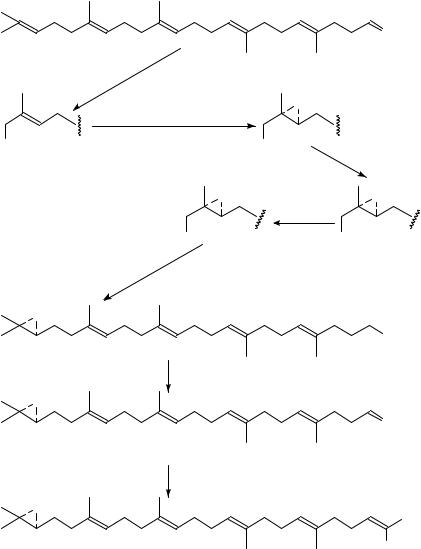
18. Syntheses and uses of isotopically labelled dienes and polyenes |
839 |
|
O |
SeO2 , t-BuOOH,CH2Cl2 |
|
|
O |
t-BuOOH, L-(+)-diethyltartrate |
|
° |
|
Ti(OPr-i)4 , 3A molecular sieves, CH2Cl2 |
OH |
OH |
|
|
TsCl, Py, CHCl3 |
O |
O |
|
NaI, acetone |
I |
OTs |
HMPA |
|
NaBH3 CN |
(71) |
|
|
O |
|
|
OH |
PDC, NaOA c, CH2 Cl2
O
O
(196)
(14 CH3 )2 C  PPh3 , THF
PPh3 , THF
O
14 CH3
14 CH3
(195)
PDC = Pyridinium dichromate
The 14C-chloroacetate of N-acetylcolchinol 199 and the 14C-isothiocyanate 200 were also found to react covalently with tubulin, but in a non-specific manner167, contrary to compounds 197 and 198 which react covalently with the colchicine binding site on tubulin with a ˇ-subunit: ˛-subunit marking ratio169 of about 4:1.

840 |
Mieczyslaw |
Zielinski´ and Marianna Kanska´ |
OR2
R1O
A
MeO
B
C NHCOMe
MeS
O
(197)R1 = 14 COCH2 Cl, R2 = Me, specific activity 55 mCi mmol−1, radiochemical yield 26.1%
(198)R1 = Me, R2 = 14 COCH2 Cl, specific activity 55 mCi mmol−1, radiochemical yield 5.7%
(201)R1 = H, R2 = Me
(202)R1 = Me, R2 = H
OMe
R2
A
MeO
B
C NHCOMe
R1
(199)R1 = O14 COCH2 Cl, R2 = OMe, specific activity 56 mCi mmol−1, radiochemical yield 7.8%
(200)R1 = NCS, R2 = O14 CH3 , specific activity 50.0 mCi mmol−1, radiochemical yield 32%
(203)R1 = OH, R2 = MeO
12.Synthesis of 14C-labelled FK-506, 204
The immunosuppressant compound170 FK-506, similar in effect to cyclosporin A, the leading drug for use in immune system suppression to prevent rejection of transplanted organs171, has been labelled at carbon atoms 10, 16, 18, 21a, 24 and 26 by fermentative biosynthesis using sodium [1-14C]propionate as a precursor172. The same 13C-labelled positions were derived from [1-13C]propionate. FK-506 producing culture Streptomyces tsukubaenis no 9993 has been utilized in this biosynthesis (120 h incubation at 29 °C).
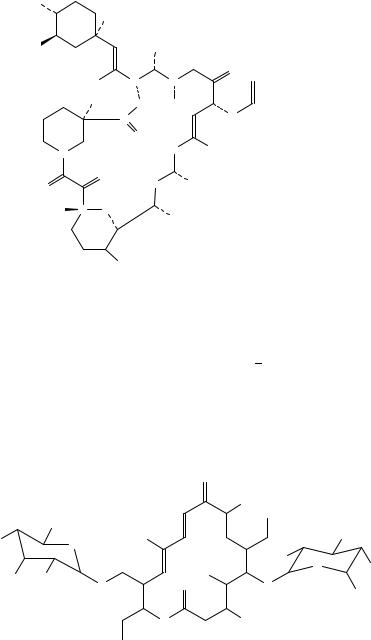
18. Syntheses and uses of isotopically labelled dienes and polyenes |
841 |
|||
HO |
|
|
|
|
|
H |
|
|
|
MeO |
|
Me |
|
|
|
26 |
24 |
O |
|
Me |
* |
* |
|
|
C |
C |
|
|
|
H |
O |
HO |
21a |
|
|
|
|||
|
|
|
* |
|
|
C |
|
C |
|
|
|
|
|
|
|
O |
|
|
|
N |
|
*C 18 |
Me |
|
|
|
|
C = 14 C |
|
|
O |
*C16 |
Me |
|
O |
|
|
||
HO *C |
O |
OMe |
|
|
10 |
|
|
||
Me
OMe
(204) FK-506, 3.6 mCi after HPLC, 0.6% from 614 mCi of [1-14C]propionate (specific activity 57.7 mCi (mmol−1).
13. Synthesis of 14C-radiolabelled tilmicosin
Tilmicosin 205 has been 14C-labelled on the 3,5-dimethylpiperidinyl side chain173 by reductive amination of the C-20 aldehyde of desmycosin 206 with 3,5- dimethylpiperidine hydrochloride-3,5-14C, 207, using 95 97% formic acid in boiling chloroform (equation 72). The required 3,5-lutidine radiolabelled in the piperidine ring, has been prepared in a six-step radiosynthetic route starting with 2-14C-diethyl malonate as shown in equation 73. 205 (EL-870) is an antibacterial174 used in treating respiratory diseases in cattle and swine. Radiolabelled EL-870 was required for biochemical studies. It is currently under development as a parenterally administered antibacterial agent for treatment of pneumonic pasteurellosis in calves and for use in feed for the control of pasteurella pneunomia in pigs.
|
|
|
O |
|
|
|
|
|
Me |
|
|
|
Me |
|
CHO |
|
|
|
|
|
|
NMe2 |
|
HO |
O |
Me |
|
|
|
|
|
|
|
||
|
|
|
HO |
O |
OH |
MeO |
MeO |
|
Me |
||
|
|
|
|||
O |
O |
|
|
||
|
O |
|
Me |
||
|
|
|
|
|
|
|
|
O |
Me |
|
|
|
|
Me |
|
|
|
(206) |
72 |
|

842 |
|
|
|
Mieczyslaw |
Zielinski´ and Marianna Kanska´ |
|
|
|
||||||||||||
|
|
Me |
|
|
|
|
|
|
|
|
|
|
|
|
Me |
|
|
|
|
|
|
|
|
*C |
|
|
|
|
|
|
|
|
|
|
|
*C |
|
|
|
|
|
|
|
|
|
NH , HCOOH |
|
|
|
|
|
|
|
|
|
|
|
|
||||
|
|
|
|
|
|
|
|
|
|
|
|
|
|
|
|
|
||||
|
|
|
*C |
|
|
|
|
|
|
|
|
|
|
|
|
|
|
|
|
|
|
|
Me |
(207) |
|
|
|
|
|
|
|
|
|
N |
|
*C |
|
|
|
||
(206) |
|
|
|
|
|
|
|
|
|
|
|
|
|
|
Me |
|
|
|
||
|
|
|
|
|
|
|
|
|
|
|
|
|
|
|
* |
|
14 |
C |
||
|
|
|
|
|
|
|
|
|
|
|
|
|
|
|
|
|
C = |
|
||
|
|
CHCl , 2 h reflux under N |
2 |
|
|
|
|
|
|
|
|
|
NMe2 |
|
|
|
||||
|
|
|
3 |
|
|
|
|
|
|
|
|
|
|
|
|
|
|
|
|
|
|
|
|
work-up |
|
|
|
|
|
|
|
|
|
|
|
|
(72 continued ) |
||||
|
|
|
|
|
|
|
|
|
|
|
|
HO |
O |
|
OH |
|||||
|
|
|
|
|
|
|
|
|
|
|
|
|
|
|
|
|
|
|
||
|
|
|
|
|
|
|
|
|
|
|
O |
|
|
|
|
|
Me |
|
|
|
|
|
|
|
|
|
|
|
|
|
|
|
|
|
|
|
|
|
|
|
|
(205) EL 870, |
97% yield, total activity 19.5 mCi, specific activity 6.48 mCi mmol−1 |
|||||||||||||||||||
COOEt |
|
|
|
|
|
|
|
|
|
|
|
|
|
|
|
Me |
|
Me |
||
|
|
EtOOC |
|
|
|
|
COOEt |
|
|
|
|
EtOOC |
|
|
COOEt |
|||||
C |
CH2 I2 |
|
|
* |
|
|
* |
|
|
|
|
* |
|
* |
||||||
|
|
C |
|
|
|
C |
|
|
MeI |
|
C |
|
C |
|||||||
|
|
|
|
|
|
|
|
|
|
|
|
|
|
|
|
|
|
|
||
|
|
|
|
|
|
|
|
|
|
|
|
|
EtOH / NaOH |
|
|
|
|
|
||
|
|
NaOH / EtOH |
EtOOC |
|
COOEt |
|
|
EtOOC |
|
COOEt |
||||||||||
COOEt |
|
|
|
|
|
|
|
|||||||||||||
|
|
|
|
|
|
|
|
|
|
|
||||||||||
100 mCi, |
|
|
|
|
|
|
|
|
|
|
|
|
|
|
|
|
|
|
|
|
|
|
|
|
|
|
|
|
|
|
|
|
|
|
|
|
|
|
|
||
specific activity 5 mCi mmol−1 |
|
|
|
|
|
|
|
|
|
|
EtOH, H2 O |
1. KOH |
||||||||
|
|
|
|
|
|
|
|
|
|
|
|
|
|
|
|
|
2. pH = 2 (HCl) |
|||
|
|
|
|
|
|
|
|
|
|
|
|
|
|
|
|
|
|
|
|
|
|
|
|
|
|
|
Me |
|
|
|
|
Me |
|
|
|
|
|
Me |
|
Me |
|
|
|
|
|
|
|
|
|
|
|
|
|
|
|
|
|
|||||
|
|
|
|
|
|
|
* |
|
|
|
|
|
HOOC |
|
|
COOH |
||||
|
|
|
|
|
|
|
|
* |
|
|
|
|
|
|
||||||
|
|
|
|
|
|
|
|
|
C |
|
C |
|
|
165−170 ˚C |
* |
|
* |
|||
|
|
|
|
|
|
|
|
|
|
|
|
|
|
|
C |
|
C |
|||
|
|
|
|
|
|
HOOC |
|
COOH |
|
|
|
|
|
|||||||
|
|
|
|
|
|
|
|
|
|
|
|
HOOC |
|
COOH |
||||||
|
|
|
|
|
|
|
|
|
|
|
|
|
|
|
|
|
|
|||
|
|
150−155 °C, under N2 , 24 h |
|
|
|
|
|
|
|
|
|
|
|
|
|
|||||
|
|
|
|
|
|
|
|
excess powdered urea |
|
|
|
|
|
|
|
|
|
|||
|
|
Me |
* |
|
|
Me |
|
|
|
Me |
* |
|
Me |
|
|
|
||||
|
|
|
|
|
* |
|
|
|
|
|
|
|
|
* |
|
|
|
|||
|
|
|
C |
|
|
C |
|
|
LiA lH4 / THF / Et2 O |
|
|
|
C |
|
C |
|
|
|
||
|
|
|
|
|
|
|
|
|
|
20 h reflux |
|
|
|
|
|
|
|
|
|
|
|
|
O |
|
NH |
O |
|
|
|
|
|
|
|
N |
|
|
|
|
|
||
|
|
|
|
|
|
|
|
|
|
|
|
|
|
|
H HCl |
|
|
|
||
(207) 3,5-DMP, 88% step yield |
|
19.5% overall radiochemical yield |
73 |
|
14. Synthesis of 14C-labelled methylprednisolone suleptanate
The methylprednisolone suleptanate 208b, the water-soluble prodrug of the methylprednisolone corticosteroid 208a, has been labelled with 14C exclusively at the carboxamide carbon175 which was found to be metabolically stable with no loss of 14CO2 after administration to test animals and man.

18. Syntheses and uses of isotopically labelled dienes and polyenes |
843 |
OR
O
OH
HO
O |
|
|
|
|
|
|
|
|
|
|
O |
|
|
Me |
|||
(208a) R = H, |
(208b) R = |
|
|
|
|
|||
|
|
C(CH2 )6 14 CNCH2 CH2 SO3 H |
||||||
|
|
|
|
|
|
|
|
|
|
|
|
|
|
O |
|||
15. Synthesis of 14C-labelled simvastatin, 209 |
|
|
|
|
||||
This potent inhibitor of |
cholesterol |
biosynthesis has |
|
been synthesized178 by one- |
||||
pot esterification of the alcohol 210 with the acid chloride of 2,2-dimethylbutanoic[1- 14C] acid, obtained by carbonation of the Grignard reagent prepared from 2-chloro-2- methylbutane (equation 74). Desilylation of 211 afforded [14C]simvastatin 209 in 29% radiochemical yield from 14C-labelled CO2. This 14C-labelled drug was needed for elucidation of its metabolic fate in experimental animals.
t-BuMe2 SiO |
O |
RO |
O |
|
O |
|
O |
|
Me |
O |
|
|
Et C |
*C |
(74) |
|
|
||
OH |
|
O |
|
Me
(210) |
(209) |
R = H |
C = 14 C |
(211) |
R = SiMe2 Bu-t |
|
|
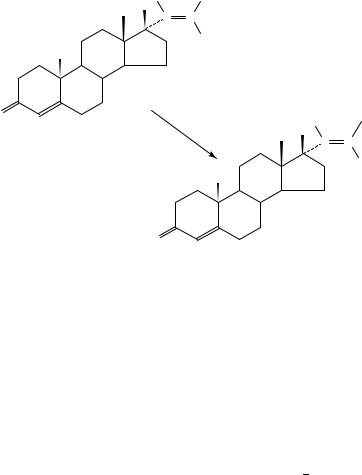
844 |
Mieczyslaw |
Zielinski´ and Marianna Kanska´ |
V. SYNTHESIS AND USES OF DIENES AND POLYENES LABELLED WITH
HEAVY RADIOISOTOPES
A. Synthesis of Iodine-125-labelled Compounds
1. Synthesis of NCA 17˛f2-(E )-[125I]-iodovinylg-19-nortestosterone
This 125I-labelled steroid hormone (E-125I VNNT), 212, needed for human breast cancer therapy, has been synthesized177 by [125I]-iododestannylation of 17˛-[2-(E)- tri-n-butylstannylvinyl]-19-nortestosterone (E-TBS VNNT), 213, using [125I]-sodium iodide/ferric sulphate in mixed CH2Cl2 water solvent, as the iodinating agent (equation 75). This avoided standard oxidants like KMnO4, KlO4, K2CrO4 or H2O2, chloramine-T and N-chlorosuccinimide which can oxidize the stannyl steroid substrate.
H SnBu3
HO
C C
H
H
O |
Na12 5I (18 mCi) |
H |
12 5I |
(213) |
HO |
(75) |
|
|
C |
||
|
|
C |
H2 O, CH2 Cl2 , Fe2 (SO4 )3 , RT, 30 min
H
H
O
(212) 10 mCi,
specific activity 2200 Ci mmol−1
Ferric sulphate is a mild oxidant and is non-reactive with the steroid substrate. It liberates iodine quantitatively (equation 76), and the iodine is extracted into CH2Cl2 and consumed as in equation 75.
Fe2 |
SO4 |
3 |
|
2NaŁI |
HC |
2FeSO4 |
|
Na2SO4 |
|
Ł I2 |
76 |
C |
! |
C |
C |
or neutral solvent
In the non-labelled reaction, 213 reacts with excess of iodine and quantitative yield of E-IVNNT is obtained177,178. The formation of E-125IVNNT, 212, is ascribed to the generation of a four-membered transition state, formed by two polarized bonds, C SnC and IC I , in which the two radioiodine atoms are shared by the two reactive centres, carbon and tin. The reaction leads to the formation of steroid-CHDCH125I and of iodostannyl compound, 125ISnBu3, which is lost during the evaporation and/or during chromatography lowering the yield of 212 to about 50% radioactive yield. The 30 90% radiochemical yield observed in 125I-iododestannylation179, using CAT or H2O2, are caused by formation of an HO I species and the product ‘C I’ and by-product ‘HO Sn’ formation (little or no iodine is captured by tin).
